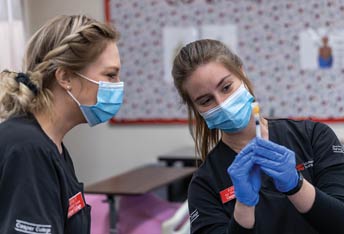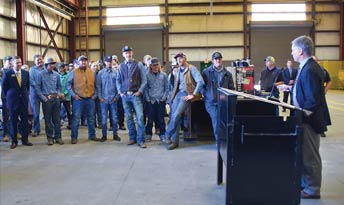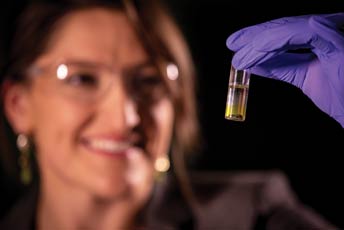
Contact Us
Institutional Communications
Bureau of Mines Building, Room 137
Laramie, WY 82071
Phone: (307) 766-2929
Email: cbaldwin@uwyo.edu
An Innovative Partnership to Serve Wyoming
Published January 24, 2022

WIP supports the Wyoming Investment in Nursing program. Pictured here, Casper
College students Savanna Pehringer and Ashley Green. (Photo courtesy of Casper College)
The Wyoming Innovation Partnership brings the state’s community colleges and UW together for economic and workforce development.
By Micaela Myers
The saying goes that Wyoming is a small town with long streets—the idea being that despite the wide-open spaces that separate us, we’re all connected. The concept applies to the new Wyoming Innovation Partnership (WIP), a collaboration among the University of Wyoming and the state’s community colleges—endorsed by Gov. Mark Gordon—to develop innovative solutions that will support and enhance Wyoming’s economy and workforce.
“WIP is an opportunity for Wyoming’s higher education institutions to take a collaborative approach to addressing the state’s workforce needs and supporting economic growth,” Gordon says. “This unified effort is the first of its kind for higher education collaboration in Wyoming and will provide new opportunities for students and additional opportunities for the people of Wyoming. We are going to help students navigate a changing marketplace, equip them with market-demanded experience and encourage and support entrepreneurship. WIP is a chance for Wyoming to utilize its resources to build a better economic future.”
This means UW and the community colleges coming together on a number of fronts—from academic offerings to support for entrepreneurs and existing businesses. Rather than a local college trying to meet a local need, efforts will focus statewide with unified goals. Federal American Rescue Plan funding—with Gordon’s allocation of $27 million—will help cover the first year of WIP.
“WIP is a framework for collaboration that will focus on what higher education can offer to build on and complement existing state efforts,” Gordon says. “A unified effort will have a larger impact by allowing the state to better focus its resources.”
Working Together
“WIP is about aligning all of higher education to work together on training students, giving them skills to succeed in the new economy and creating jobs—attracting companies and building the economy so students can stay in Wyoming,” says UW President Ed Seidel. “We have an opportunity to truly move the needle for Wyoming’s economy as we collaborate with the community colleges, private and federal partners, and others.”
The Wyoming Community College Commission aims to provide coordination for the community college system and has been very involved in WIP, which is led by the college presidents and the governor’s office. Executive Director Sandra Caldwell says WIP is a great opportunity for the state to advance economic development and entrepreneurship through the collaboration.
“The colleges and university continue to show how well they work together to impact the state, including collaborating with the governor’s office, business and industry, community partners and the K–12 system,” Caldwell says. “WIP is intended to support the state’s overall economic vision set forth by the Wyoming Business Council and support education attainment goals developed by the state, allowing the state to better focus its resources to assist both existing industries and areas identified as having significant growth potential. WIP has the capacity to move forward successfully to benefit Wyoming’s economic development and innovation due to the hard work over the last several years with efforts such as the WyoTransfer process, articulation and the attainment work, which established a strong foundation for WIP to be successful and impact Wyoming for generations.”
UW Associate Vice President of Economic Development Steven Farkas serves as WIP’s executive director. He explains that the effort began with a thorough understanding of what resources and educational opportunities are currently available. From there, they’re working on developing programmatic activities aligned with the state’s economic agenda and key economic sectors, such as energy, agriculture, advanced manufacturing, health care, hospitality and tourism, entrepreneurship and building a new economy, and computing and digital applications across sectors. These activities must produce measured outcomes, Farkas says, such as business growth and recruitment, increased access to capital, sponsored projects and research, graduate retention and enhanced industry partnerships. Because of WIP, new UW-led efforts such as the Center for Entrepreneurship and Innovation, the Wyoming Outdoor Recreation, Tourism and Hospitality Center and the School of Computing also emerged.

Gov. Mark Gordon speaks to welding career students at Puma Steel in September.
(Photo courtesy of the Office of Gov. Mark Gordon)
Workforce Development
“It’s going to be critical that all the state’s entities that drive economic development are moving in the same direction,” Gordon says. “We want more college graduates staying in Wyoming, and to do that we need to ensure we are creating educational opportunities for both traditional and nontraditional students, including adults seeking new careers.”
This includes an emphasis on workforce development in high-potential areas for the state.
“WIP is about aligning all of higher education to work together on training students—giving them skills to succeed in the new economy—and creating jobs—attracting companies and building the economy so students can stay in Wyoming after graduation,” Seidel says. “Statistics show that more than 70 percent of UW graduates leave the state, a significantly higher number than all of our neighboring states. UW and its partners aim to help build a more diversified economy that would allow our graduates to stay and, in turn, create even more job opportunities.”
Benjamin Moritz serves as deputy director of the Wyoming Community College Commission. He co-chairs WIP’s programmatic subcommittee with UW Vice Provost for Enrollment Management Kyle Moore. Their subcommittee focuses on creating or expanding programs that positively impact the economy and economic development.
“One of the most, I hope, lasting impacts of this work is a level of collaboration, respect and trust across the institutions as we discuss how we jointly can have an impact on the workforce and the economy of the state as a whole,” Moritz says. “There’s more collaboration and consensus-building because there’s no existing program that anyone is lobbying for. Instead, everyone is bringing all the ideas to the table. That’s one of the exciting things.”
One goal is to create collaborative academic programs, putting aside issues such as which institution gets credit for a class and making transferring credits easy. Organizers have identified third-party programs that make course sharing easier. So instead of a resident having to choose between moving or foregoing further education, that person can access courses right in his or her own community. Virtual reality technology also plays a part, allowing students to virtually utilize expensive equipment that may only be available at one location. An example is advanced manufacturing equipment, Moritz says.
“It’s amazing what technology can do these days,” he says. “Now you can be on the other side of the state using virtual reality to do diesel technology and work on an engine located elsewhere. We’ve done that a little, but we need the investment to take it large scale.”
Casper College President Darren Divine also serves as president of the Wyoming Community College Presidents, where he acts as the official spokesperson for the state’s now-eight community colleges. “Historically, in Wyoming and most other states, workforce and economic development efforts are undertaken at individual campuses, or perhaps a small collection of nearby campuses, with little to no coordination with the other higher education institutions in the state,” he says. “This current effort, including and coordinating the voices from all of the colleges as well as the university and working alongside various business groups around the state, is a new and exciting approach to workforce and economic development in Wyoming.”
Divine echoes Seidel regarding the lack of job opportunities in graduates’ preferred fields. “While UW as well as the colleges offer a wonderfully wide array of degree programs to choose from, many times there are no job opportunities in those areas for graduates to pursue once they graduate thus forcing them to leave the state to pursue their career goals. This effort will help align current and future business growth to match up with current educational opportunities to hopefully increase the number and diversity of career opportunities for our graduates, no matter their field of study.”
One example of a WIP collaboration took place last spring when 20 students from various Wyoming colleges gained hands-on training in software development via a two-week online intensive. It was used to pilot an innovative software development program through a partnership involving Cardiff University in Wales, United Kingdom, UW, Wyoming community colleges and industry partners. During the program that was aimed at preparing Wyoming residents to participate in the 21st century workforce and diversify the state’s economy, students worked on a short software development project with Trihydro Corp., an environmental engineering consulting firm based in Laramie.
UW has entered a memorandum of understanding with Cardiff University to cultivate academic and cultural interchange. This agreement will make available to Wyoming students an applied software development degree based on a curriculum offered by Cardiff’s School of Computer Science and Informatics. UW and the state’s community colleges are working with Cardiff and industry partners toward initially offering a two-year degree in software development that will provide a pathway to a bachelor’s degree.
“This partnership with external partners such as Cardiff, Wyoming community colleges and industry is an example of the type of program that can make a real difference in workforce and economic development in the state,” Seidel says.
Another example includes entrepreneurship curriculum, which you can read about in the feature on the Center for Entrepreneurship and Innovation.

Wyonics cofounder Kristin Di Bona. The scientific innovation company started at
UW and recently received a Department of Energy Small Business Innovation Research
grant.
Economic Expansion
Farkas says that, in addition to workforce development, WIP is also focusing on workforce retention. For example, if workers in an extractive industry lose their jobs, they may need retraining or credentialing to transfer to a new sector rather than moving out of state.
“As we think about those traditional sectors, we think about what skills are transferrable and where are the gaps, so that we—as part of the higher-education consortium—can identify those gaps, develop programmatic activities and hopefully pre-emptively provide training to those transitioning workforce members to be aligned with emerging industries,” Farkas says.
A similar two-pronged approach applies to helping entrepreneurs and aiding existing businesses.
“Most individuals that think about entrepreneurship usually do so in the context of new business creation,” Farkas says. “The real opportunities are how do we take those same resources and adapt them to support our existing business communities. So when we think about the pandemic and the strain it’s put on the state’s industries, companies are having to think very differently about how they align themselves with new marketplace demands. These new demands are requiring companies to adapt and innovate by adopting an intrapreneurial mindset.”
Farkas sees WIP and the Center for Entrepreneurship and Innovation as the conduit for sharing best practices. “The idea here is to lean on the institutions—UW and the community colleges—so they really become hubs for these activities,” he says. These entities will all have access to the same information and can efficiently point businesses or entrepreneurs to the right resources around the state, such as continuing education, applied research, business incubators, tech transfer, the Small Business Development Council and others.
Gordon says, “We want to create more opportunities for people to live and work in Wyoming in both core and new industries that lead to higher earnings and a stronger state. To do this, we will need to better connect local economic and community development plans to the state’s goals and plans. There will be a focused effort to develop programs or initiatives at institutions of higher education having significant growth potential. New opportunities reside in growing our existing business communities, concurrent with activating new and complementary businesses through the partnership.”
Contact Us
Institutional Communications
Bureau of Mines Building, Room 137
Laramie, WY 82071
Phone: (307) 766-2929
Email: cbaldwin@uwyo.edu


